If you've been following our adventures for a few years, you may remember that we made the crazy bet of spend the winter in Quebec in an Airstream trailer in 2018/2019. Looking back, it's time to make yourself a little feedback from these 6 months hibernated in Canada. A review and advice who may be able to help some to spend the winter in a caravan, trailer, tiny house, mobile home, van, campervan, camper van, and any other tin can on wheels.
Small reminder for those who did not follow: in the summer of 2018 we were stranded in Central America with our Popo van because of the civil war that was raging in Nicaragua at the time. Our PVT (residence permit) in pocket for Canada, we then made the decision to go up all north and experience life in winter in Canada.
Of course, out of the question to put it in the van, it would have been totally impossible, but at the same time, out of the question for us that it is not on 4 wheels.
The Airstream which was a real dream for years, so turned out to be a good compromise but you will read it in this other article, we had a few surprises despite everything.
Okay, let's be clear, when we brought up the idea to Quebecers, we were taken for crazy ... They even managed for a moment to make us doubt.
But it takes more to get an idea out of our heads!
Airstream purchased (we present it to you here), restored (it's happening there) and land to land found thanks to our friend Olivier (thank you again to him for having us welcomed here), at the beginning of December 2018 we are almost ready to face winter!
You understand the goal was not to ride in winter with in Canada, which would have turned out to be very very complicated, but to ask in the same place for several months with this trailer being connected to water and electricity.
We will do a more specific article for you on VanLife and winter mobility shortly.

Lucky for us, we did not have -40 ° C all winter. The temperatures have continued to oscillate with a constant of -15 ° C during the day. But all it takes is a cloud, a ray of sunshine, for the wind to pick up for the so-called acceptable temperatures to become freezing! And believe us it happens very often! Not to mention that night falls early in the heart of winter (around 3:30 p.m.).
Not to mention that it is important to differentiate the "Actual temperature" of the " felt temperature ".
“The felt temperature takes into account not only the measured temperature but also the wind speed and the ambient humidity. » For example, "A real temperature of -10 ° C in a wind of 30 km / h can be felt as a temperature of -20 ° C". (www.futura-sciences.com)
Our daily life in this cold management was therefore keep an eye on our thermometer (exterior, interior temperature, percentage of humidity,…), presence of wind and its direction, maintenance of interior heat and suitable outfits both when we go out and when we stay inside the Airstream.
As with life in a van, that's the key word, but here in Canada with extreme temperatures it makes even more sense. It should be understood that in -40 ° C and with 2 meters of snow some things are no longer feasible and therefore have to be plan ahead. It's hard when it's the first time that we spend a winter in Quebec to think of everything and anticipate everything, but we tried to the maximum with the wise advice of our friend Olivier, expatriate for several years and who has a few winters behind him. After several discussions and even if we have already experienced very negative temperatures, especially in a van, we realized that there, it could still be a step above and that clearly if we were not well prepared, the consequences could be dramatic! So let's get to the heart of the matter.
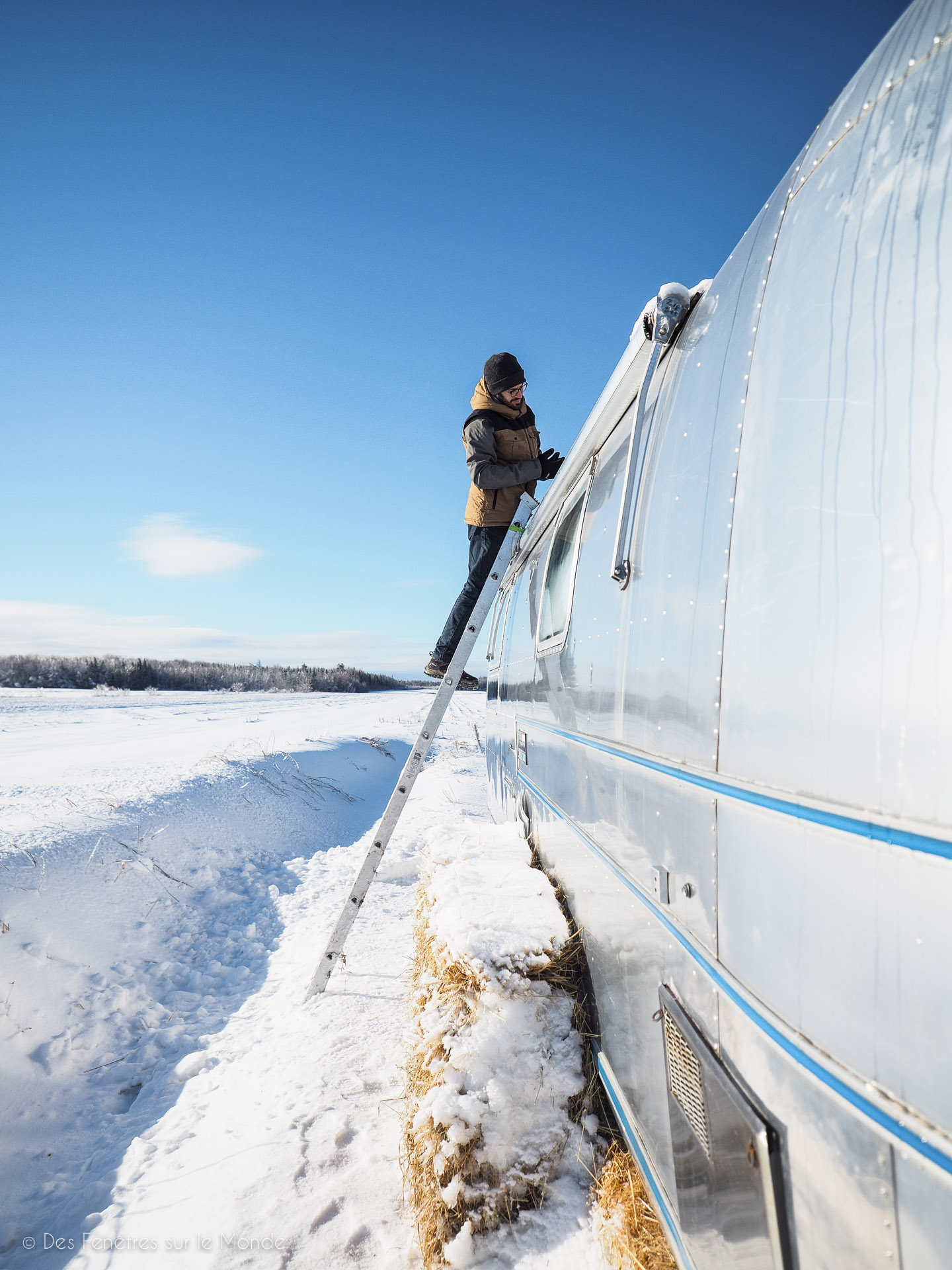
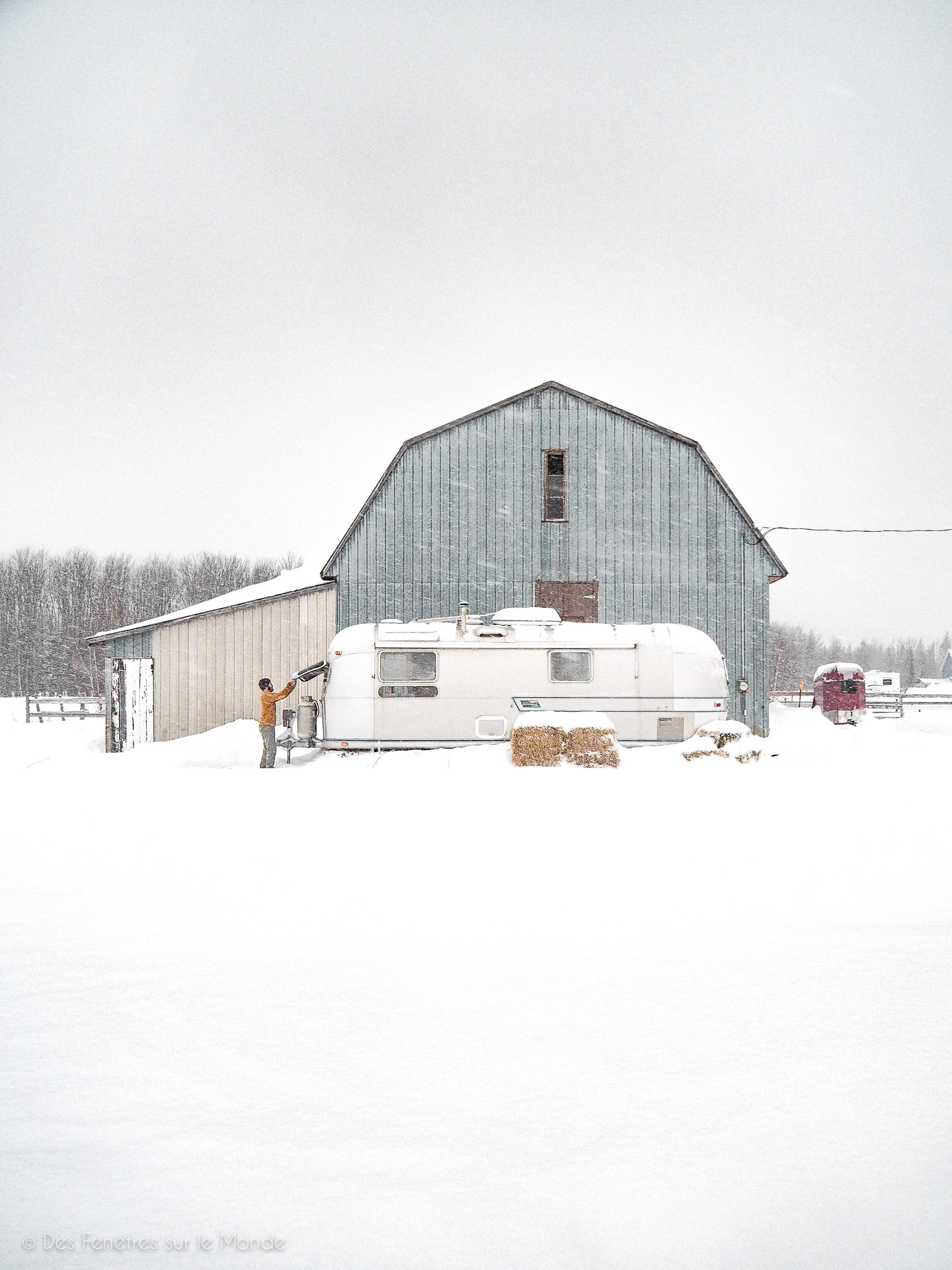
It is strategic, it will influence a whole bunch of parameters to be taken into account, but we did not expect to have so much trouble to find a place to spend the winter with our Miss Alu. It was without counting the winter, campsites are closed, the water shut off outside to prevent the pipes from freezing and exploding.
The solution of land on private land is therefore the only possible if you're going to get into that.
In our case, we didn't have a lot of options but in the end it was perfect, we had our two requirements: to be connected to water and electricity and we had a great winter at Ranch Edward.
We quickly realized that the region, the terrain, the location and the position in which to install the trailer could greatly influence certain parameters.
We were in the middle of the fields, with only a sheltered side of the barn, without a tree around us, exposed to the wind. Not great so would you tell us to avoid freezing in place but on the other hand great for avoiding heavy snow accumulation. Less snow to shovel, less work and less risk of being blocked.
If you find a location under trees it can be a good compromise, less snow on the ground and more sheltered from the wind. But the other point to take into account is the sunshine. Being under trees or in the shelter of a hill can be a good thing, except that you have to remember to be exposed to the sun as much as possible during the day! This is really a very important point. On sunny days without wind and in -20 ° C we did not put on heating. It is therefore essential to think about it for the winter.
Location can change everything, it can constrain you more than it brings you and vice versa.
This is the basis ! Insulate yourself as much as possible from the cold and keep the heat. Airstreams are totally isolated original (wall, ceiling, floor), it is therefore already a good basis. As we mentioned in the article of presentation, they are designed to be used down to -10 ° C without too much trouble for a short period. It was therefore necessary to improve its insulating capacities as much as possible with the means at hand and at low cost.
- Straw bales
Some still remember it, once installed on our site for the winter, the first thing we did, the first snows having arrived much earlier than usual that year, was to insulate the underside of the caravan to prevent the wind from rushing in and cooling it from below.
So we used straw bales to fill the space. Straw is known for its natural insulating abilities. Straw houses are being built in some parts of the world and it is not for nothing… The good surprise was that our host had old bales of straw in his barn unused and no longer edible for animals who had the perfect size to slip between the mainland and the Bellypan (under floor) of the Airstream. A chance ! A little elbow grease and 28 bales of straw later here is the result:
A few weeks later and with the heavy snow, we are therefore totally isolated from the ground, we just leave a small ventilation hole which also serves as a passage for cats. Quite frankly, we felt a huge difference between the first days spent without this insulation and those after, although colder. A good way, therefore, when you are stopped for a while, to isolate yourself from the cold and in addition it is natural!
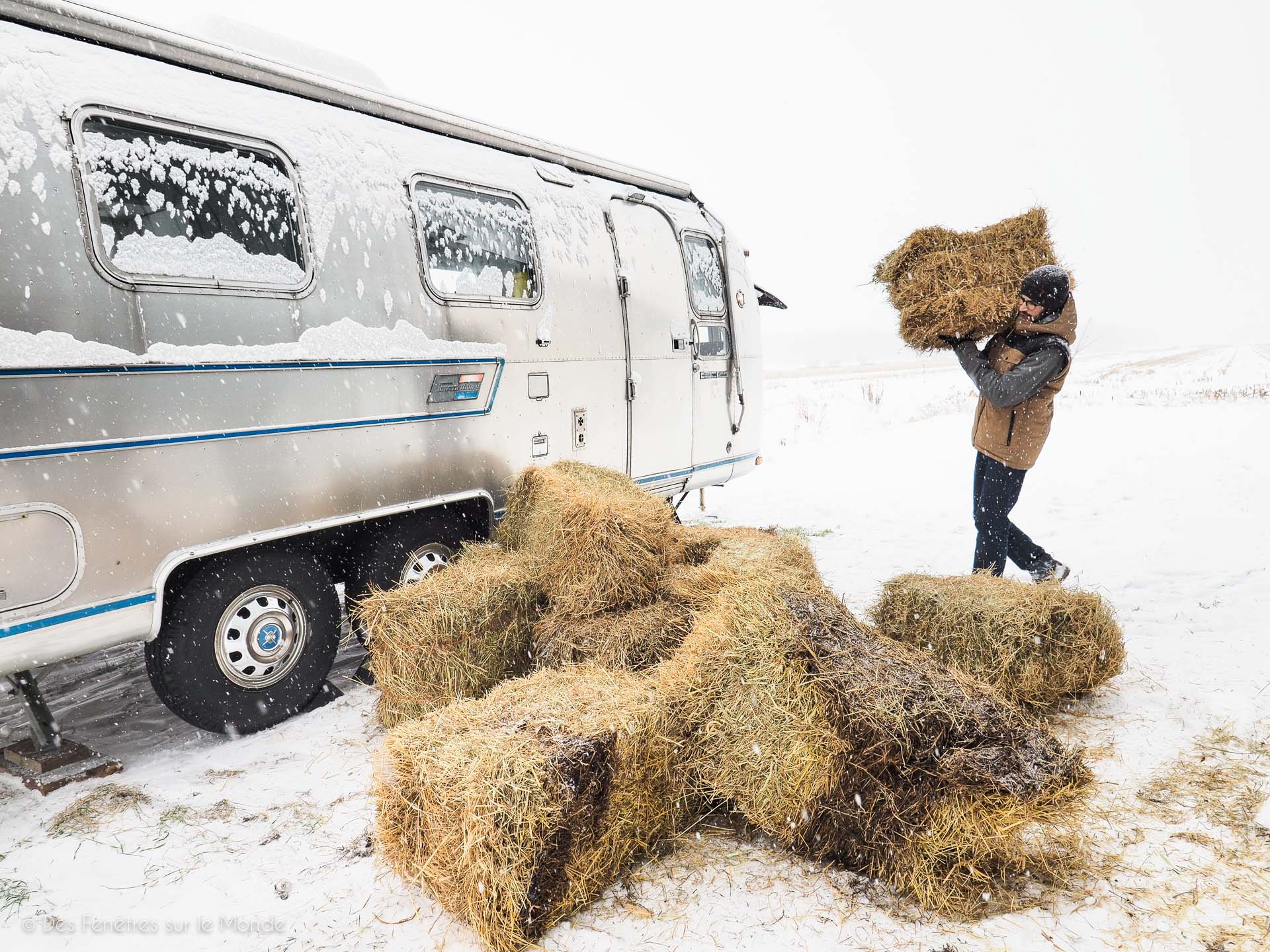
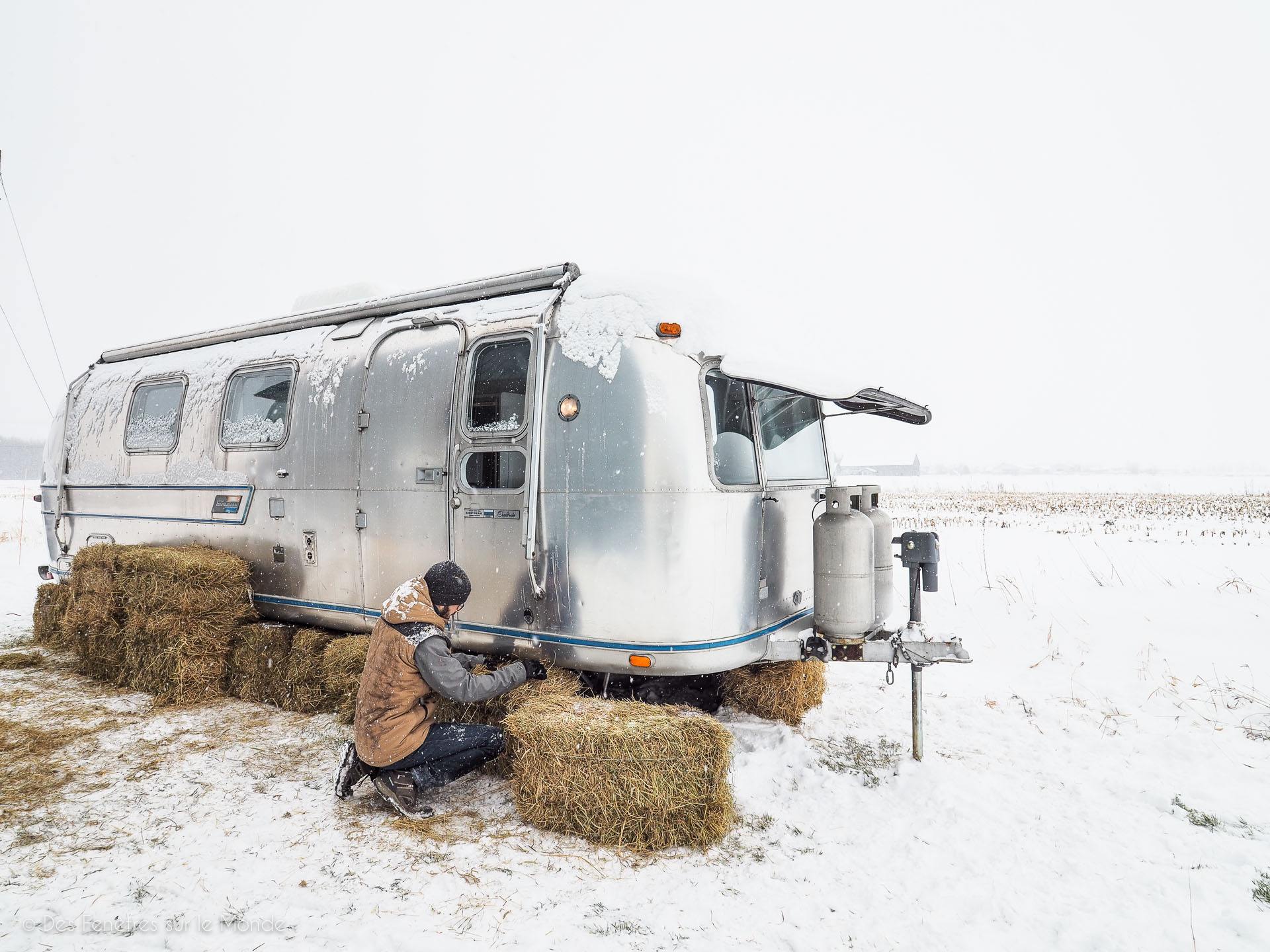
- The additional insulation
Admittedly the trailer is isolated from origin, but by renovating it we quickly realized that we could easily provide additional insulation. Thin insulation has therefore proven to be a good way to improve its capabilities. In North America, you can easily find rolls of bubble insulation with an aluminum face. The aluminum face is inside and allows to keep the heat, the air between the two faces acts as an insulator (yes the air is an insulator). In France and Europe, ideally we will rather use multi-layer insulation which is an accumulation of several layers of insulating material and aluminum. By the way, the latter has better insulating abilities than bubble wrap but it is a bit more expensive.
So here we are to isolate all the surfaces that we can taking care to avoid thermal bridges by overlapping the angles and taping them with aluminum adhesive.
The test is conclusive and easy to verify. By touching an uninsulated surface with this additional insulation and an insulated surface, you can clearly feel a temperature difference. After winter we have of course left all these insulators which are not visible and which will also do their job whatever the season.
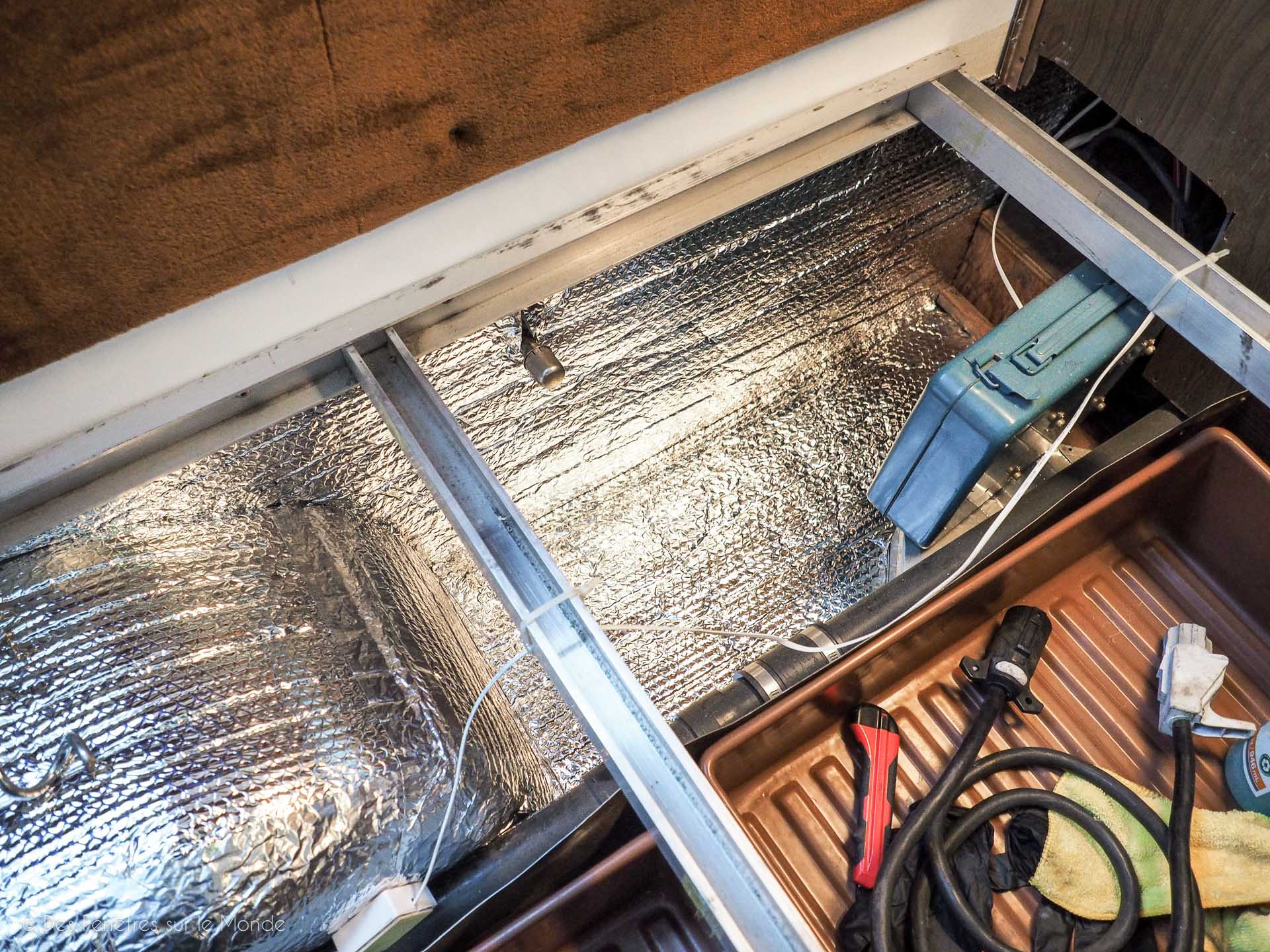
- Window film
It's all well and good, but you've noticed that there are a lot of windows on an Airstream (that's why we like it so much too), and that makes quite a lot of space.
At the time, in 1974, the date of manufacture of this large aluminum tin can, double glazing was a rare option. We have double glazing only on the front of ours (the large bay window which makes the rounding). Well that's not bad… But we can do better!
There are totally transparent plastic films that allow you to easily create a second skin and thus a kind of double glazing. So we tell you right away, it is of course not the same at all and not as efficient but we tried to take a pack and install it on all the windows. We had removed the original mosquito nets, for the winter it is useless, right ?! And so we installed this famous movie instead. It is installed using a double sided provided and once in place we tend it as if by magic with a hair dryer or a heat gun. The plastic shrinks and forms a perfectly smooth and invisible film (we got screwed a few times).
Result: The most glaring thing was visible at the level of condensation. Proof that the system works, the temperature difference between the very cold outside side of the glass and the warmer inside side, should have formed a lot of condensation and this was not the case, only on days when the temperature dropped below. -30 ° C. So the film does its job well as we say there, the air between the latter and the glazing is used here again as insulation.
We would have liked to have had an infrared thermometer to test the surfaces and have precise data, but that will be for next time.
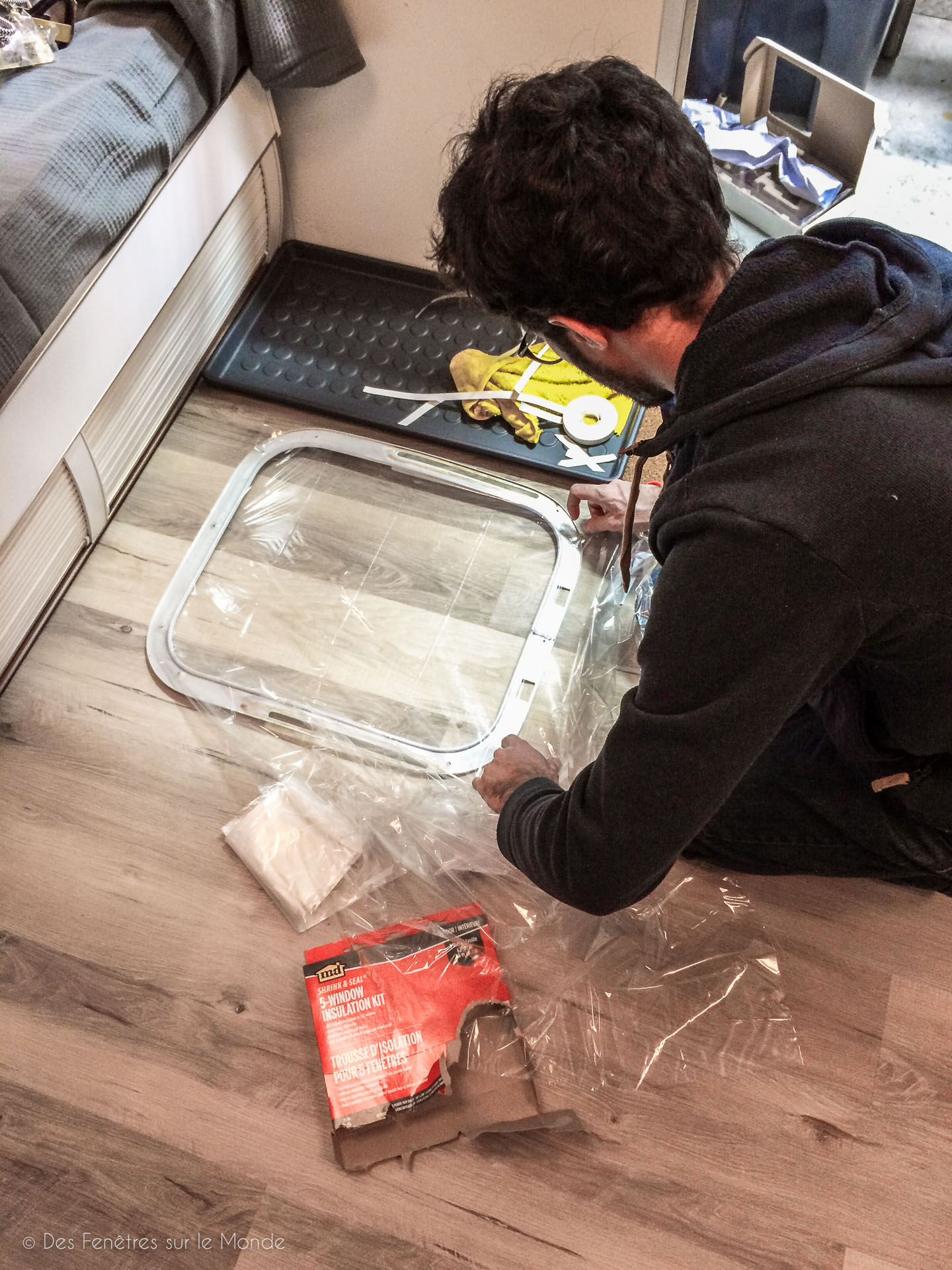
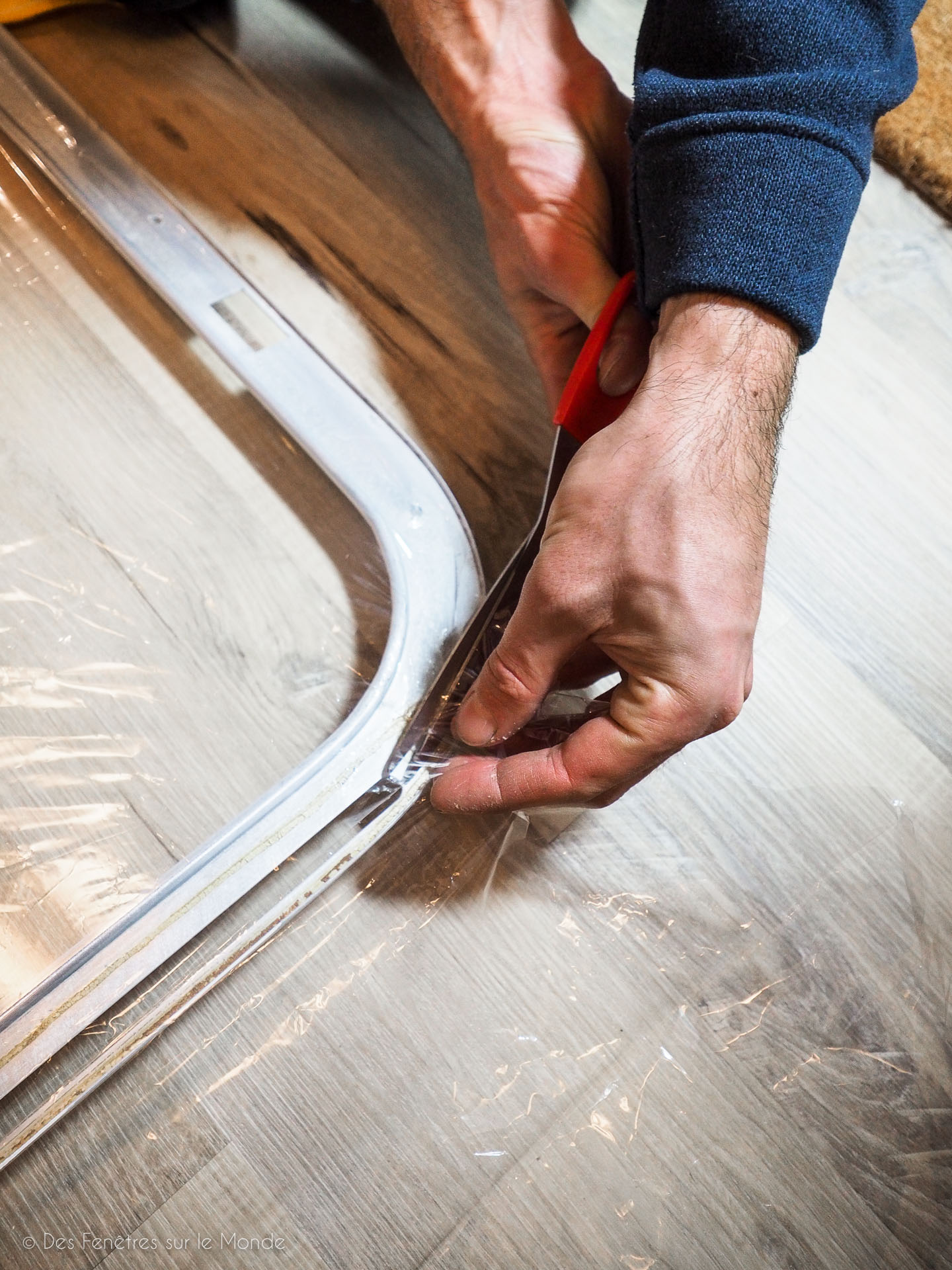
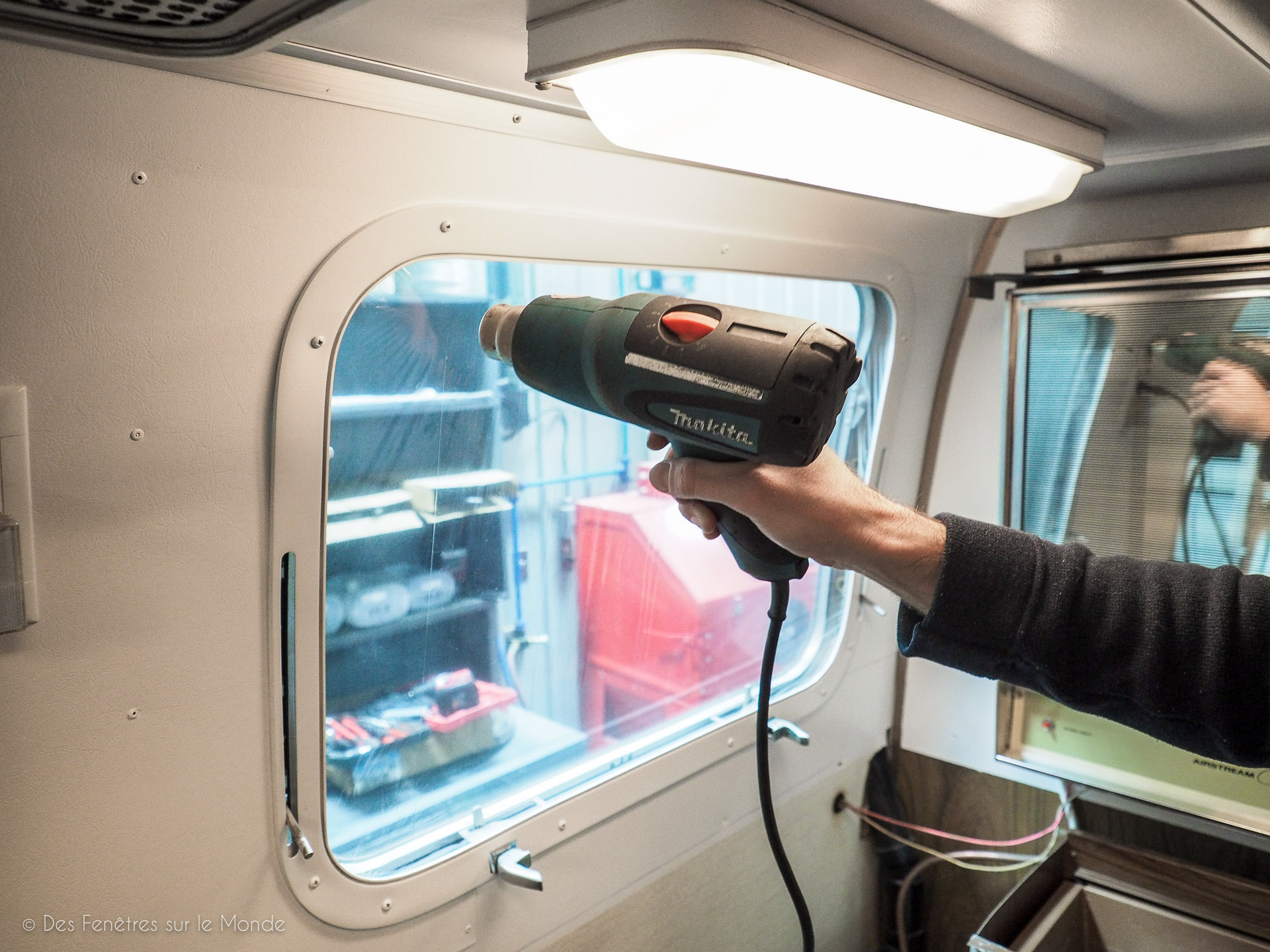
Insulating yourself is good, but heating yourself is better! Well, better… let's say it's complementary. The volume of an Airstream is not huge and you may find it easy to heat. In principle yes, but when it's very (very) (too?) negative outside it can be a real challenge. In any case if it is not one, it is the basis for surviving the Canadian winter and any cold winter.
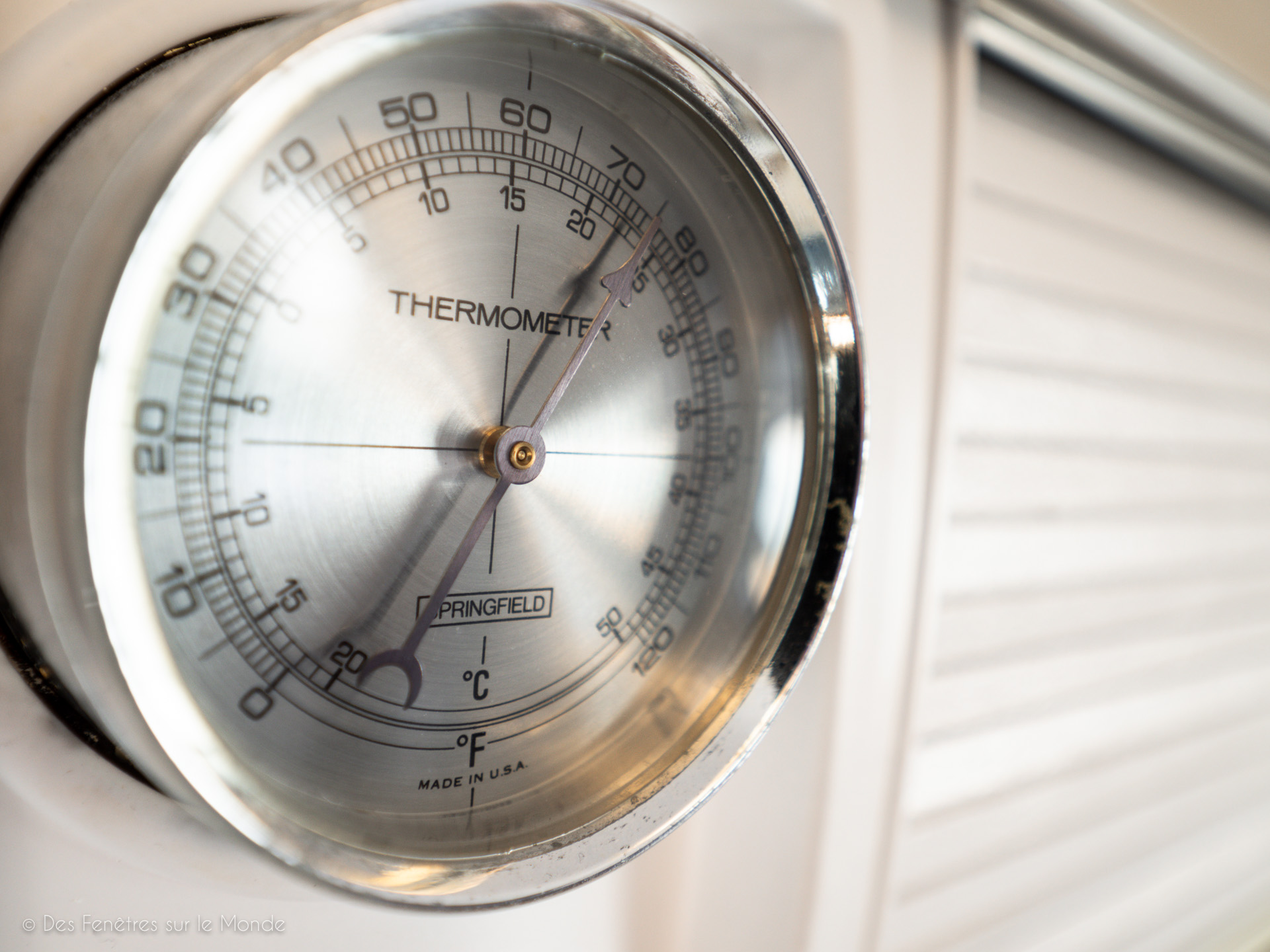
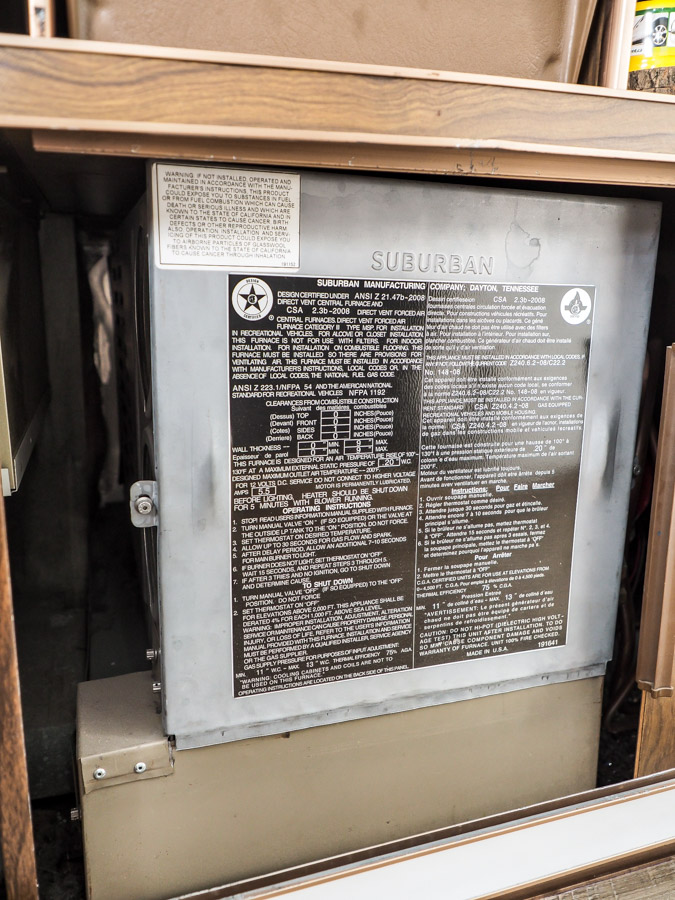
- Propane heating
Original, you may have seen it in his presentation, the Airstream has propane central heating. It's that big metal box over there... A boiler produces heat and it is distributed in each room via ducts up to the various air vents. The system is very well thought out since heats the water pipes in passing to keep them frost-free. There is a thermostat to regulate the temperature, it heats up quickly and it is a pleasant heat. Its only flaw is its consumption ... The first days of our installation after our first tests in -10 ° C at the beginning of winter, we consumed an entire 40 pound (18 kg) propane cylinder in just 2-3 days! It's huge, and most of the winter was not yet here! And for good reason the heating was constantly on… Not viable therefore, at around 30$ charging, it's expensive at the end of the month ... At the end of winter, however, with spring arriving and the temperatures dropping just above freezing, propane turned out to be our best friend. The thermostat would turn on the heat when needed and we could last 3 weeks without a problem. Namely that we also have the water heater which works with this energy, as well as the oven and the hobs. It is therefore a very good means of heating but not sufficient when winter is really very very harsh and especially not great for the wallet over a long period like this.
- The wood stove
The solution, and we had anticipated it, was therefore toinstall a mini wood stove. Mini because the volume to be heated is small and so is the space.
We easily found this in Canada where wood stoves are legion. One of the makers of this style of stove is based in Montreal a few hours away, so we were able to pick him up directly. This is the Grizzly model from the CubicMiniStove brand (they also deliver to Europe), the biggest of the range (yes there is still smaller). They are so cute!
Of course, of course, we had to drill a hole in the Airstream to pass the duct to Joana's dismay (who doesn't like holes, everyone knows), but it was for a good cause.
In use this little stove turned out to be amazing, it was our main source of heat. It shoots really well. During the first tests by pushing it a little, we raised the temperature to 30 ° C in the Airstream with -25 ° C outside. After taming it, we managed to maintain a temperature of + 20 ° C all winter, perfect and so cozy!
For the logs are mini too, we were lucky to have a friend who has a woodlot a few kilometers away and who kept us all the chutes of his big logs. It only remained to split them to obtain the ideal size, in addition it made us do our sport of the day in fashion. Canadian lumberjack!
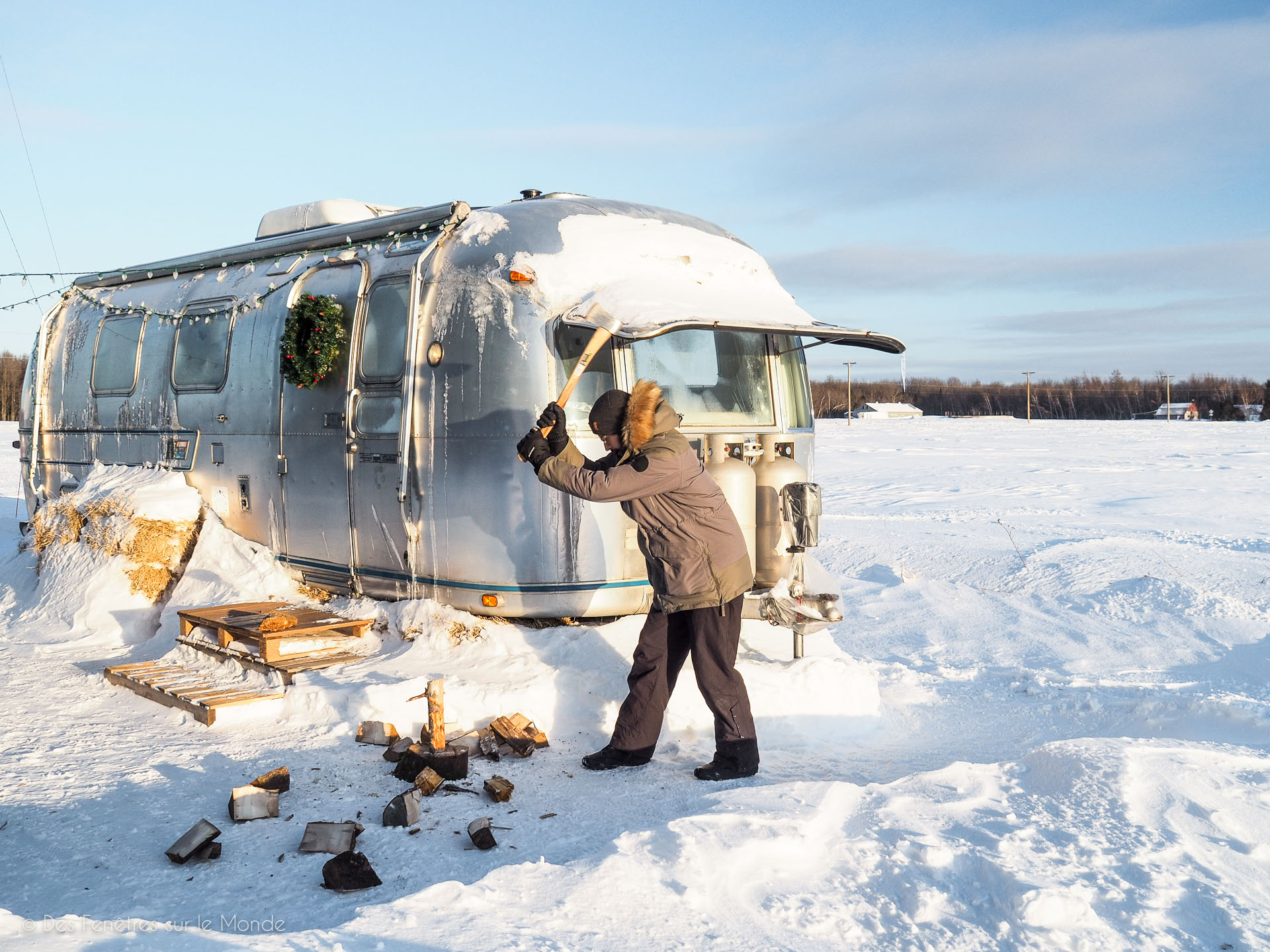
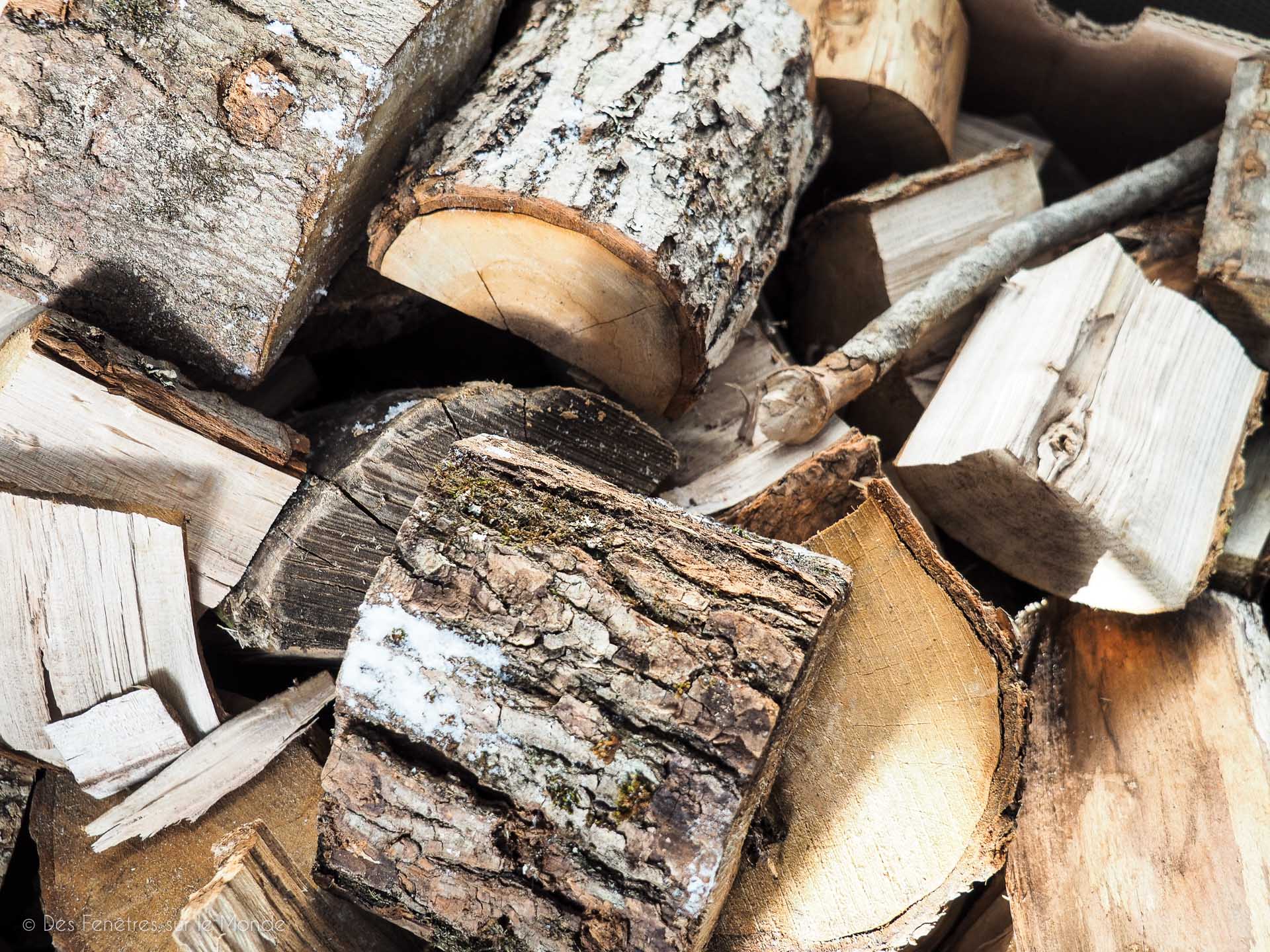
Good of course, at night it was more complicated to keep the right temperature and prevent the fire from going out completely without getting up every 3-4 hours. As much to say that almost every morning, it was off and thatit was 3 ° C inside when I woke up. A little propane heat (luckily the thermostat was right at the headboard), and 15 minutes later we found a correct temperature.
To keep the fire a little longer lit at night, we often used compressed wood logs. These are "false" logs, composed of compressed wood chips without any glue additive (it is the resin in the wood fibers that makes the binder), so it is 100% natural and they have the advantage of burning more slowly by adjusting the wood stove properly (air supply and extraction to a minimum). The downside in our opinion is that they tend to produce a little more soot and therefore prematurely foul the duct and the window. Use instead in addition to wood logs therefore…
Speaking of inconvenience, are there any? Not really, apart from emptying the ashes, cleaning the window (3 minutes flat for all that) and chopping the logs with an ax (but that's rather pure pleasure!). The disadvantage was rather indirect, we can explain.
If you followed correctly (we see one at the bottom sleeping ...), the stove allowed us to limit the use of propane heating at least: a little in the morning, sometimes to regulate during the day or when we came back from a long walk. The problem is that the water pipes remain frost-free thanks to the propane heating… Can you make the connection ?!
So we found ourselves a few times without water during big storms when the temperature inside was perfect, the pipes had frozen and you will see in this other article that we had our share of surprises ...
Big chapter this wood stove is not it? But clearly without him, this winter in -40 ° C would simply not have been possible! Thanks to him, we recharged the propane bottle every 2 weeks and more 2 days, as much to tell you that the purchase quickly paid for itself.
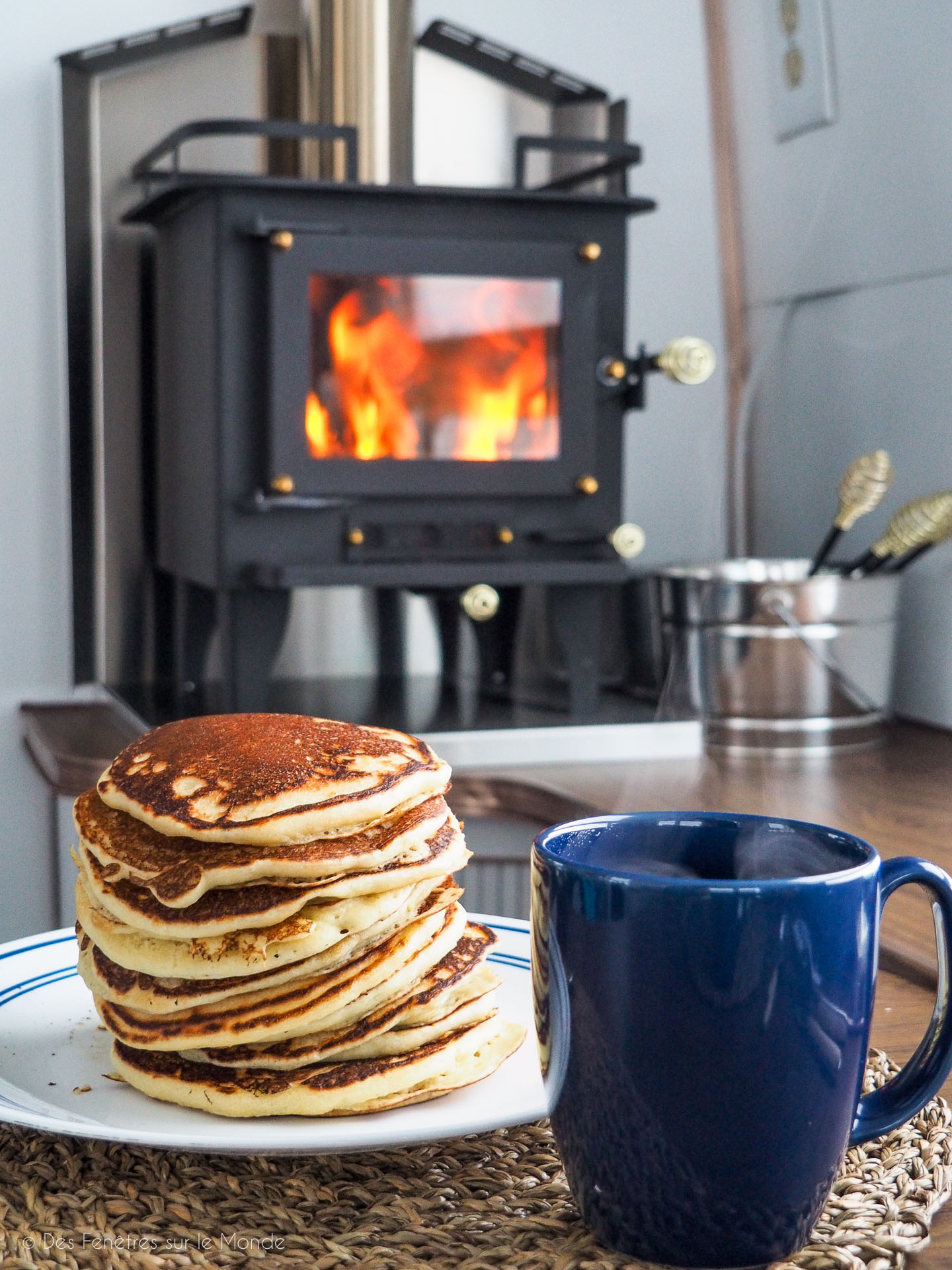
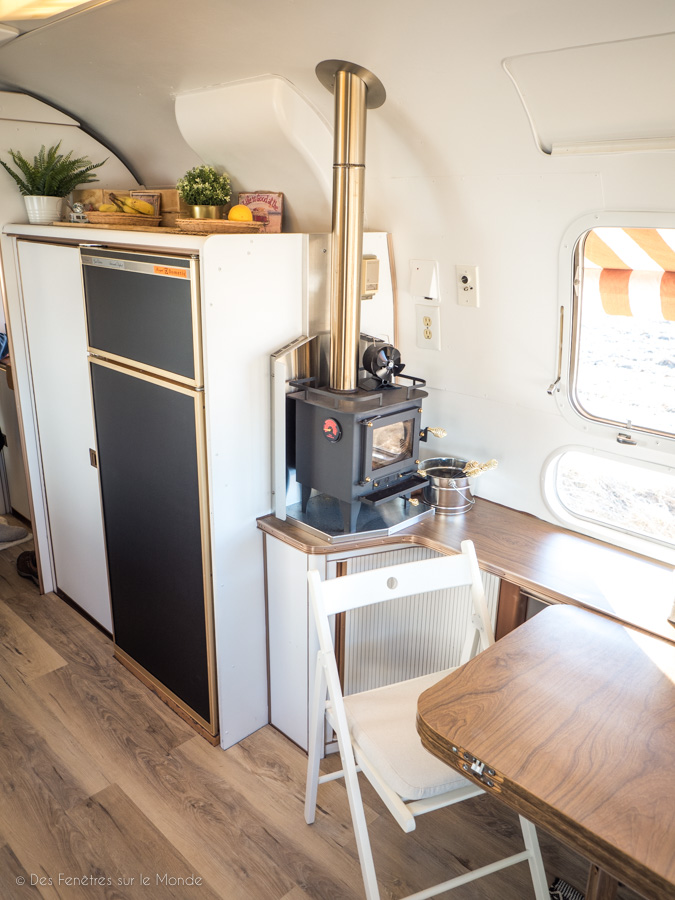
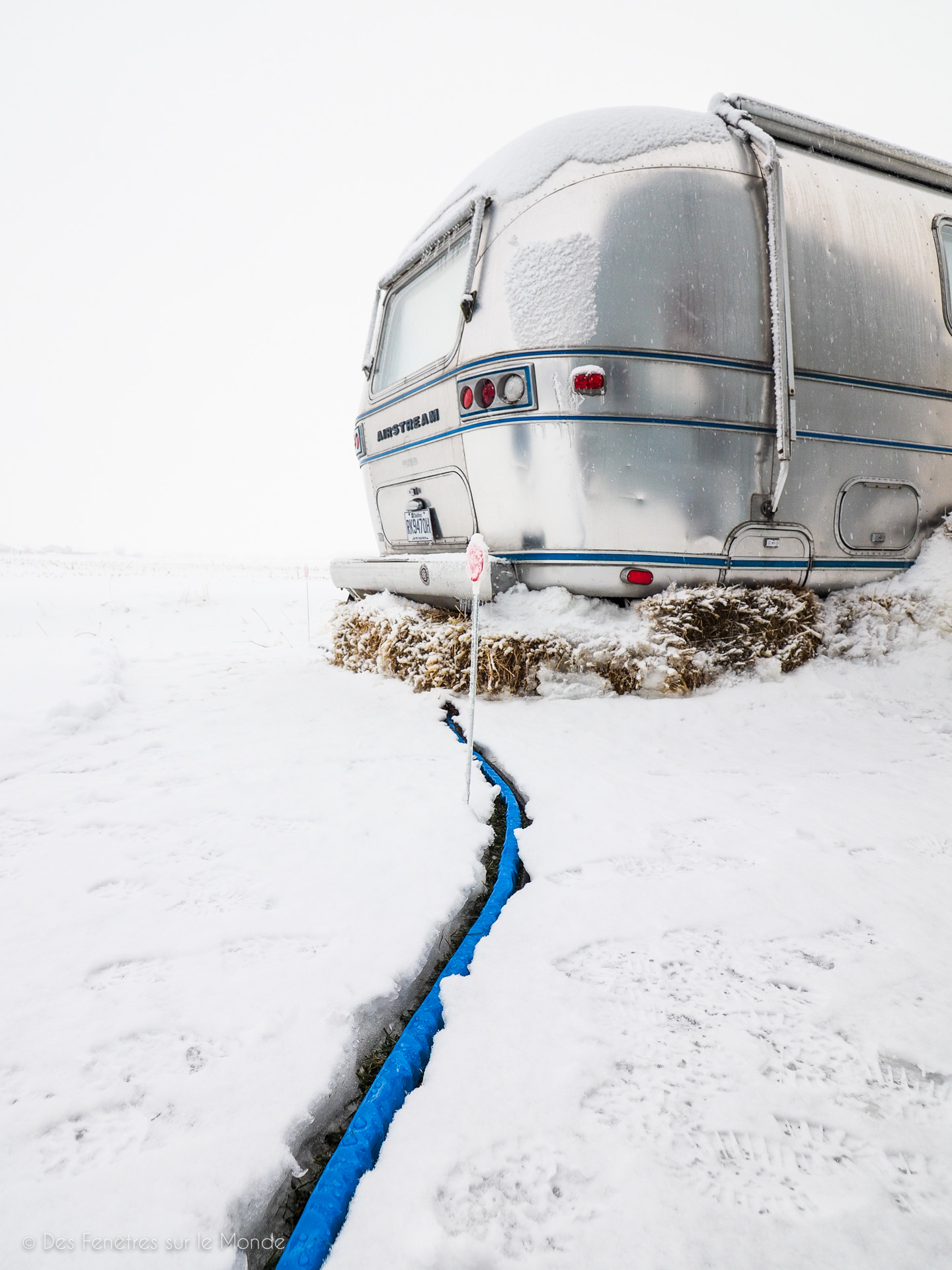
- Water: the heating pipe
This is the base, having water… Imagine having to take snow and melt it every day (well, we did that too…). It would be a full time job! Unthinkable therefore not to be connected. We talked about it, it was one of our conditions to be able to spend the winter serenely.
We were therefore about ten meters from the running water outlet of our friend Olivier's farmhouse. It was still necessary to bring the water to the Airstream… But in America everything exists, even the heated water pipes! It is a classic looking pipe but in the sheath is hidden an electric wire which creates a small heating resistance.
We see some coming: water> electricity> hum… Of course everything is planned, it's done for, no risk and very very low power consumption, the resistance is equipped with a thermostat which triggers only when necessary and keeps the hose frost-free. He NEVER froze! More than practical therefore, essential for those who want to connect a caravan, a trailer or a tiny house during the winter months.
There are also antifreeze heating cables which are installed on existing pipes and allow them to be kept frost-free in the same way.
- Electricity
The second condition for us was obviously to have electricity, in particular to work. As the stand-alone 100% option is excluded at this latitude and especially in winter since the solar panels do not have a good enough performance (very low sun, few hours of sunshine and the snow covering the panels), it has we had to connect to the farmhouse. But not just any old way! The cold (always him) requires to have adapted equipment. The cable must keep its flexibility despite the cold (there are special cables for this) and the plug must be suitable and waterproof. As in France with the blue "camping" sockets, in America there are specific sockets coupled with cables of large section allowing to pass, to put it simply, "a lot" of electricity. Yes, because even if we do not consume a lot of electricity, there may be peaks when the refrigerator turns on and when we turn on the microwave at the same time for example. So we have on our arrival installed a "camping" outlet outside the farmhouse, connected alone to the electrical panel on a 30A circuit breaker (this is the standard below).
Nothing too complicated but common sense, we must not forget that a fire started by an electrical problem quickly happens!
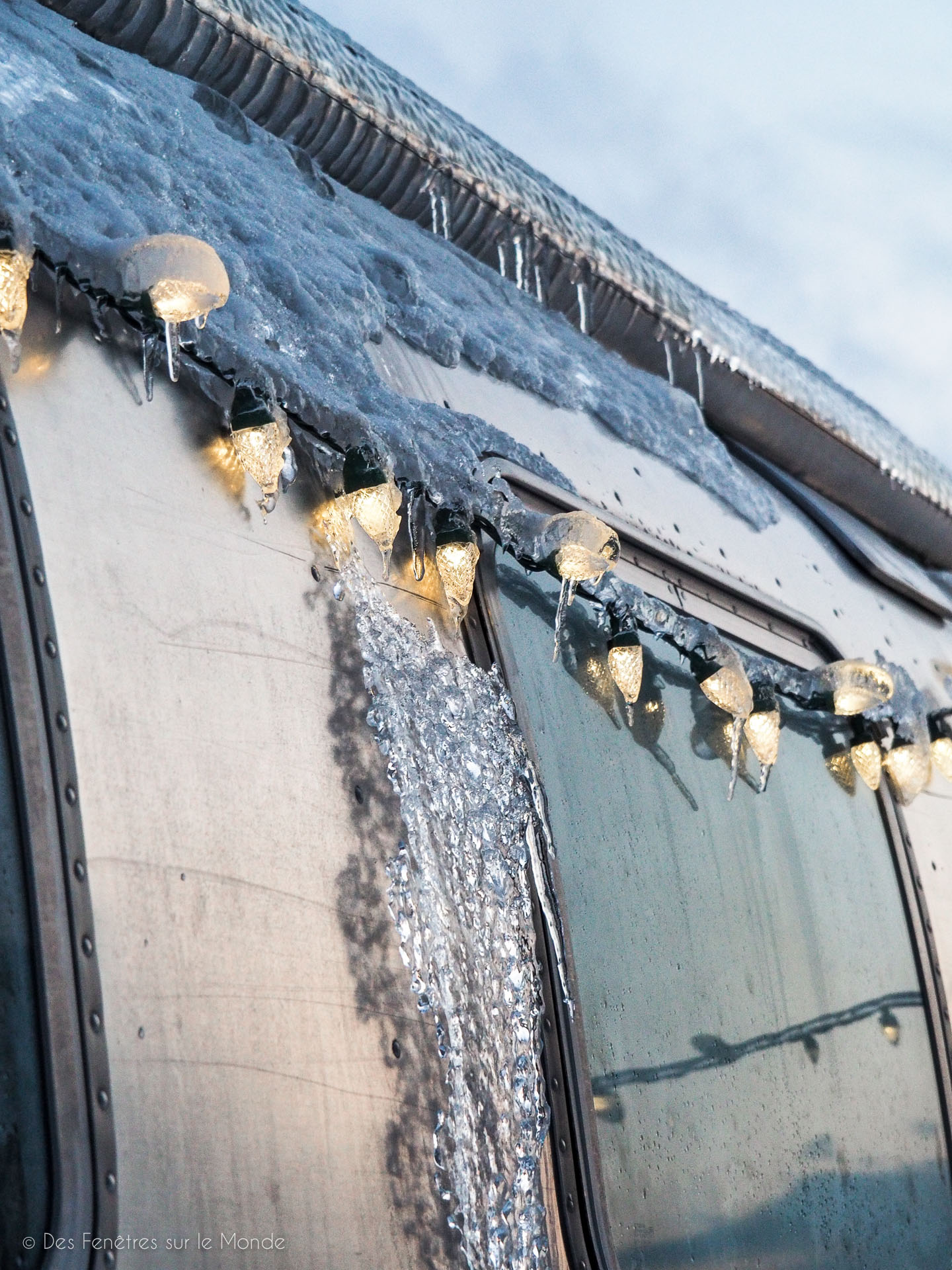
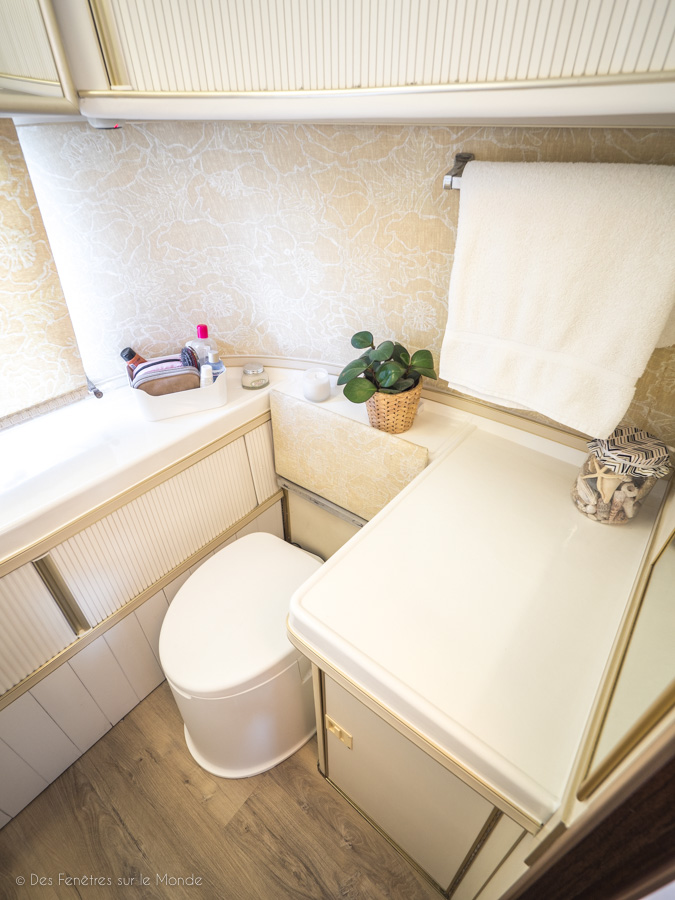
- The sewerage
Well, it's simple… we didn't have any! We have therefore found a very simple alternative solution for toilets: dry toilets.
Exit the original toilet! We unbolt, we stop the evacuation and here is the new toilet is ready to be installed. For two reasons we bought a ready-made toilet. The first is that we will have to have other projects with our Airstream and that we will therefore have to reinstall the original toilet. The second goes hand in hand, is that we wanted a non-invasive ready-to-use solution.
Okay, we'll skip the details, but to keep it simple; after each use we put sawdust and once full it would join the pile of manure not far away. This is the advantage of being next to a small farmhouse, so our needs went with those of our animal friends (basically we are also animals, let's not forget that).
Better to prevent than to perish, er… cure forgiveness… But the first term can be true! You are never too careful with the cold.
It is necessary always plan a plan B, never be satisfied with a single source of heating for example and have good blankets and a backup heater in case. We repeat, we are never too careful ...
To have food reserves also, we have lived it several times, storms can sometimes last for several days and better always have non-perishable food in reserve and water.
Knowing how to anticipate in general is a reflex to take, we think of wood: always have a reserve inside or even think of turning off the water when leaving for a long time. Everything is longer and requires more preparation, it must be understood thatonce winter arrives, it becomes impossible to do certain things. For example, you have to wait for warm weather to repair the exterior, you can no longer easily tinker with the door open in a small space like this.
In short, we come back to our introduction: know how to anticipate! And for that, when you do not know a country and the situation, you have to discuss with the locals, learn from them, from their experience and not take their advice lightly.
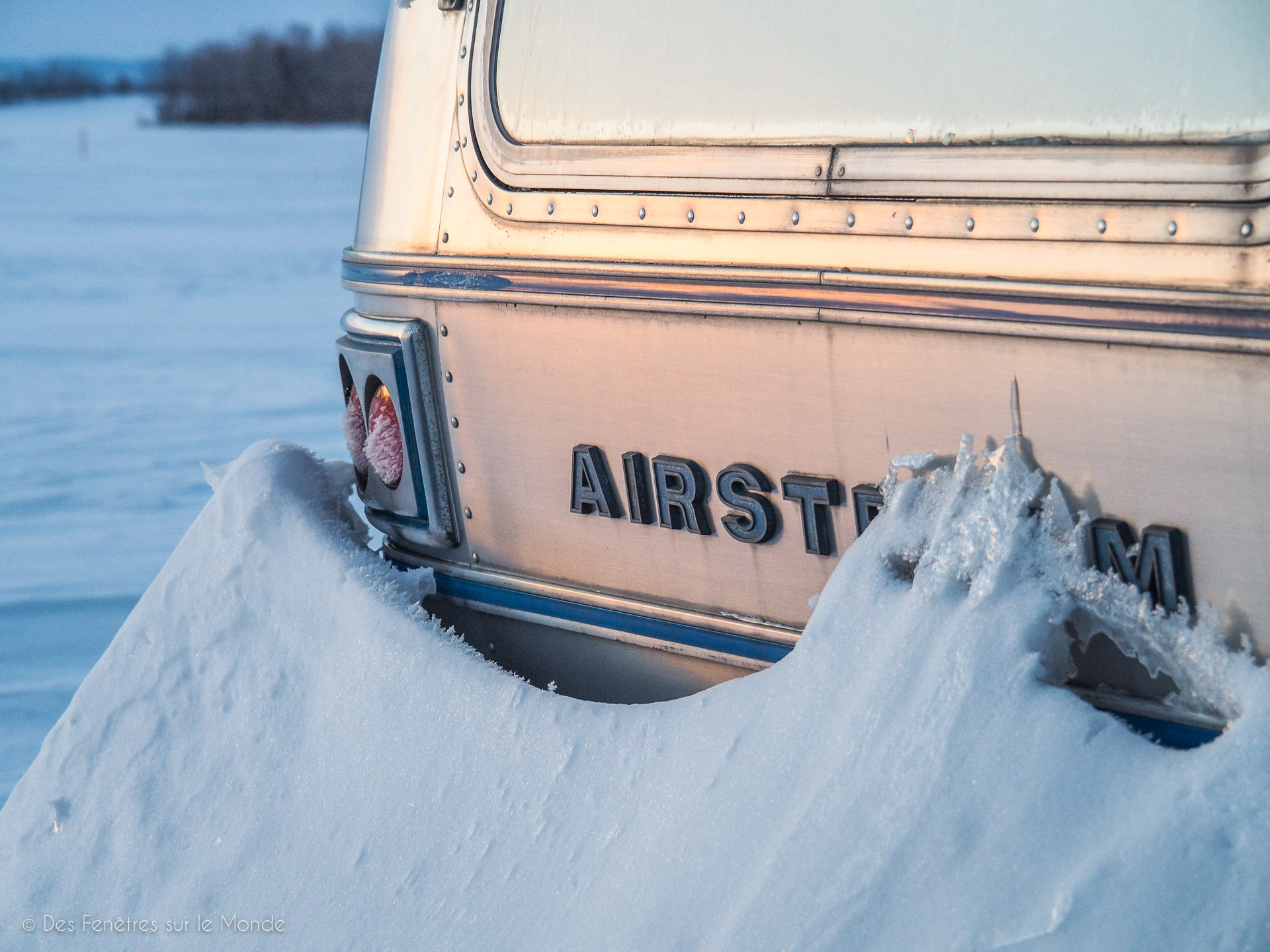
The notion of go into hibernation It therefore makes perfect sense here. Prepare for winter, experience winter and get out of winter. Three stages, like bears, which are repeated every year for all those who live in countries like Canada.
If adventure tempts you, whether it's for a weekend in a cabin or for the whole winter in a tin can, we therefore advise you to prepare yourself as well as possible and try to anticipate the unexpected. Which may seem quite difficult and contradictory.
Living in a “fixed” Airstream in winter in Canada and living in a van all the time in motion and in all seasons is totally different, we will tell you about it.
The pace was definitely not the same in Miss Alu. The time seemed frozen and we literally lived according to the weather, even more than in Popo despite being static.
Each degree counts and influences the way we live. Cold, storm, freezing rain, wind, sun… You have to provide enough drinking water, food, wood, propane, anticipate that the pipes can freeze…
But anticipating and knowing do not mean that we can not be surprised!
The cold and the frost especially get in everywhere, more water or on the contrary water leak ...
Finally, since 2015, what we remember the most about our lifestyle is thatyou have to constantly adapt. And even if at times, it is just not the moment, that it is a little tiring, that some must think that we are crazy, we like challenges! Our choices, our life ...
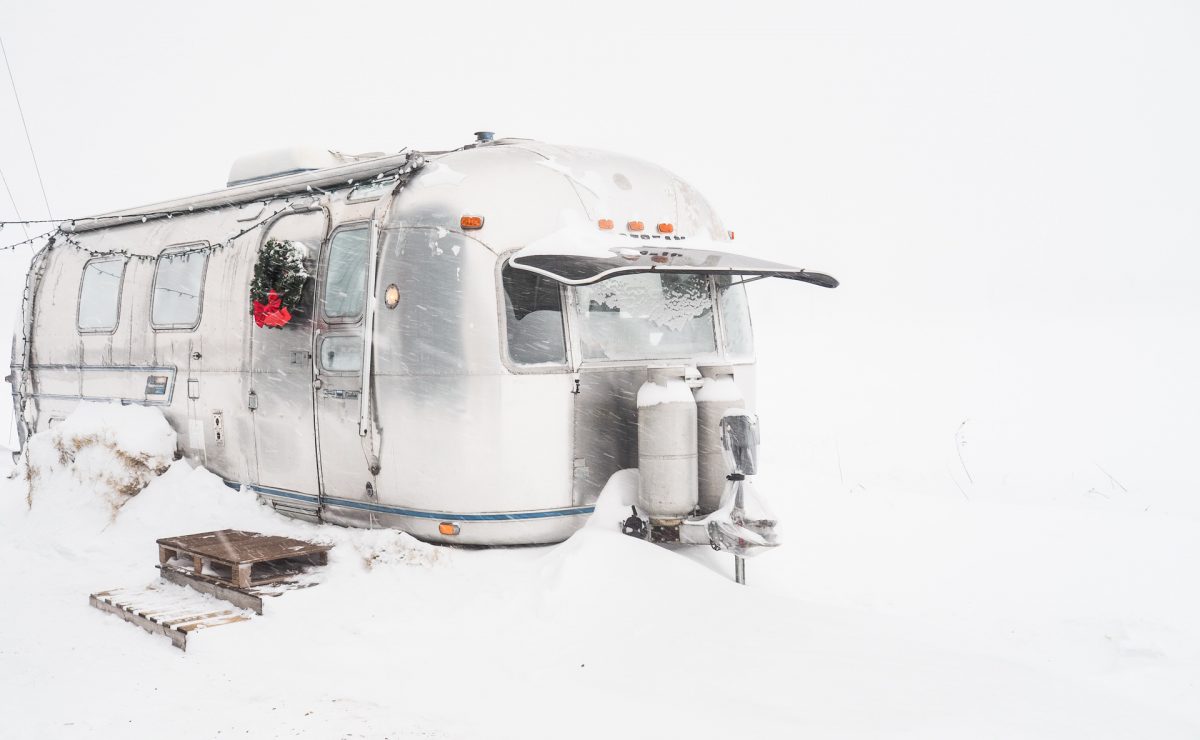
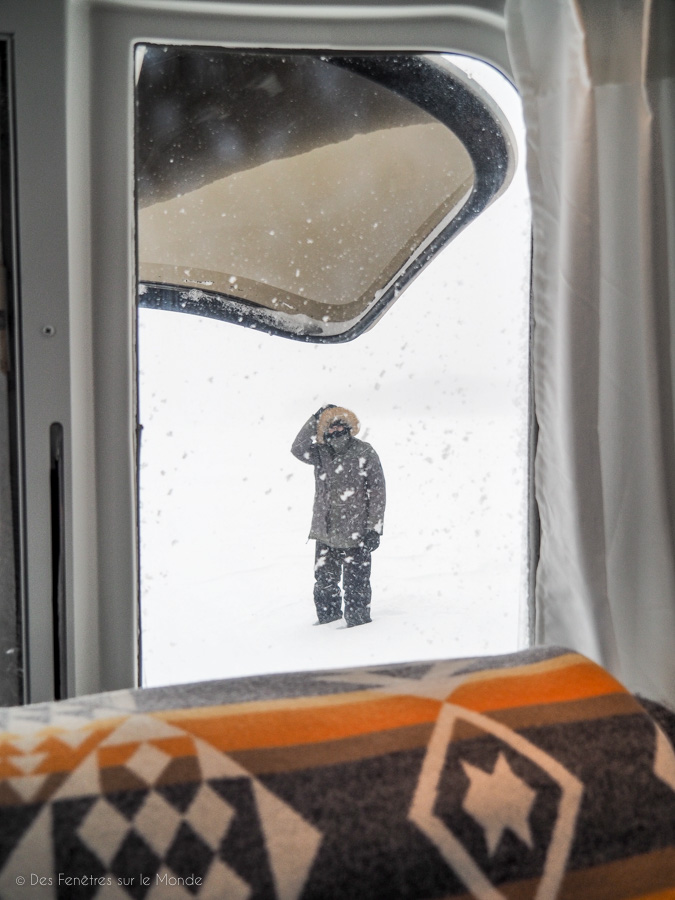
This winter was quite an experience and looking back on it we don't know or no longer know if it was all real! But we did, those who thought we were crazy still think so, those we couldn't say that deep down they believed in us.
Surprising, unsettling, each adventure is clearly different.
Miss Alu is resting for a while for the moment (period not defined), warm in a storage shed in Quebec. Don't worry, it's not over, we have some plans for her!
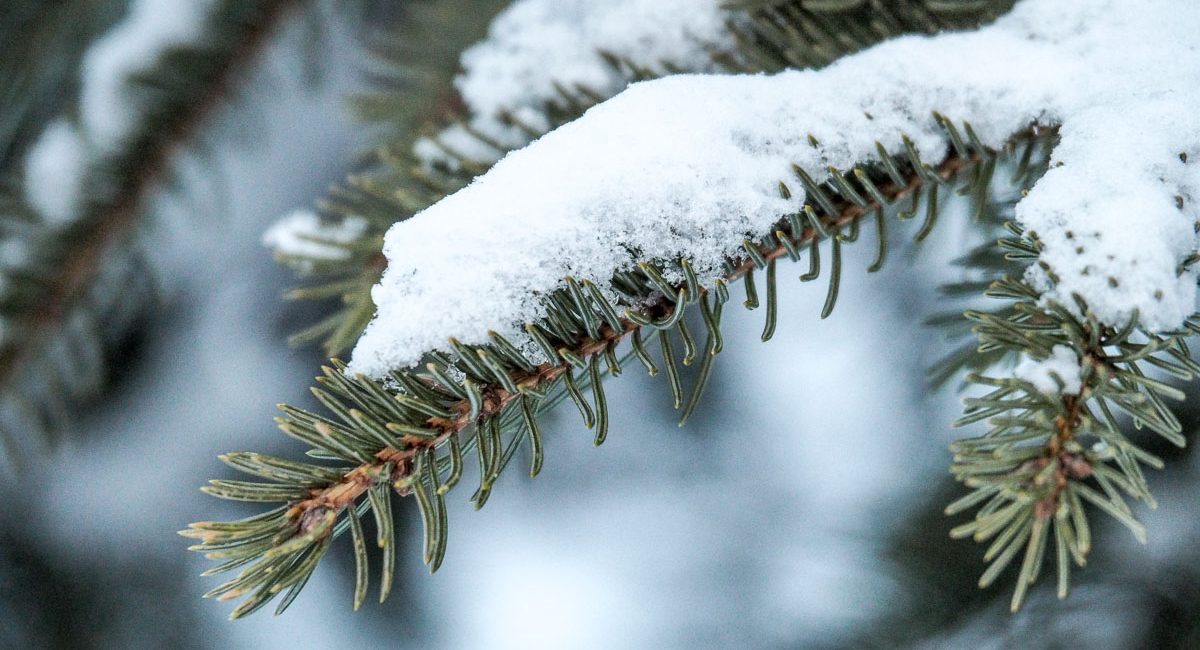
So much for the side practical and technical life on wheels in winter. These tips should of course be adapted depending on your case and / or your project but we hope that it will be useful to you and allow you to anticipate a little more certain aspects to take into account in winter wherever it is, because who can do the most can do the least.
Well you will see that this did not prevent us from having our lot of galleys during those few months.
We let you discover it all here!






What an amazing experience! Real adventurers! Well done and thank you for this very detailed article. I can't say how many things I learned, but a whole lot! I only have this word that comes back to me: Incredible !!
It was really crazy when you think about it! Freezing cold but only good memories!